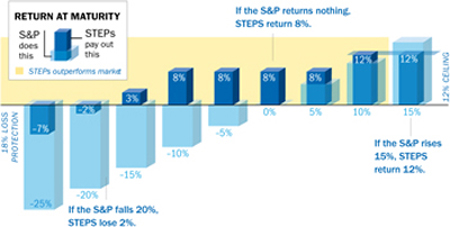Filed Pursuant to Rule 433
Registration No. 333-158663

| STEP Income Securities® (STEPS®) are Market-Linked Investments designed to give you regular income in addition to growth potential. STEPS are debt securities of an issuing company that are linked to an asset. They’re usually linked to a single stock, though there are also index-, currency- and commodity-linked STEPS, among others. |
| STEPS pay quarterly interest coupons based on a fixed annual rate. At maturity they may also pay an additional “STEP Payment” if the linked asset exceeds a predetermined “Threshold Value” (which is usually the same as the return represented by your interest payments). Downside exposure to declines in the linked asset is on a one-to-one basis, but it is mitigated by the STEPS interest payments and | some STEPS have an additional buffer against a certain percentage of the losses. Like other corporate bonds, STEPS are also subject to issuer credit risk. STEPS are available in $10 increments (minimum purchase of $1,000 required), with maturities ranging from six months to two years. They can be purchased in new-issue offerings or in the secondary market. They’re |
registered with the Securities and Exchange Commission and may be listed on public exchanges. STEPS can express a bullish or a bearish view, with bearish STEPS paying a STEP Payment if the linked asset declines by a percentage equal to or greater than your interest rate.
How can STEPS play a role in my investment strategy? STEPS offer a way to combine some of the features of growth stocks with those of dividend-paying stocks and traditional debt securities. Suppose you own a large concentration of stock in a single company and are concerned about the risk that represents. You might sell some of that stock and buy an equal amount of STEPS linked to the same stock. Regardless of how the stock performs, you’ll receive regular interest payments. And if the stock increases (or, in the case of bearish STEPS, decreases) by a percentage greater than the return from your interest, you’ll still be able to capture some of its additional upside. | ||||||||
|
Payout Profile Shown here are hypothetical payouts at maturity for STEPS linked to a single stock. They feature a one-year maturity, an annual interest rate (and Threshold Value) of 8% and a 4% STEP payment.
|
||||||||||

|
||||||||||
Hypothetical information is not a projection of future returns.
This Investor Education Guide provides an overview of STEPS only and does not provide the terms of any specific security proposed to be sold. Merrill Lynch will furnish you with a prospectus that contains the terms of the relevant offering. Prior to making any decision to invest, you should read that prospectus for a detailed explanation of the terms, risks, tax treatment and other relevant information. Additionally, you should consult your accounting, legal, or tax advisors before investing.
Prior to selling any particular STEPS, the issuer will have filed a registration statement, including a prospectus, with the Securities and Exchange Commission (SEC) containing more complete information about the potential offerings described in this Investor Education Guide. Before investing, you should carefully read the relevant prospectus and the other documents filed by the issuer with the SEC. You may obtain these documents without cost by visiting EDGAR on the SEC Website at www.sec.gov. Alternatively, the issuer or Merrill Lynch will arrange to have the documents sent to you by calling Merrill Lynch toll-free at 1-866-500-5408.

 MARKET DOWNSIDE PROTECTION
MARKET DOWNSIDE PROTECTION MARKET ACCESS
MARKET ACCESS ENHANCED INCOME
ENHANCED INCOME ENHANCED RETURN
ENHANCED RETURN